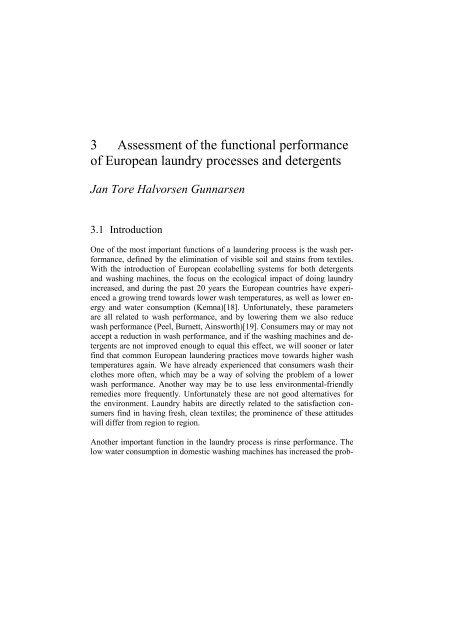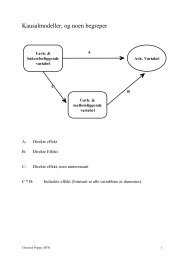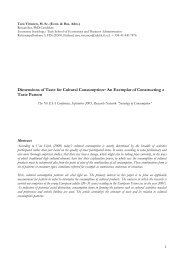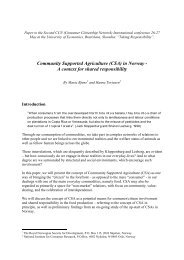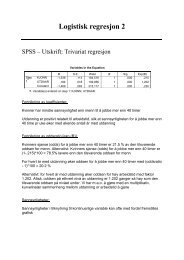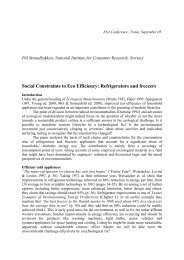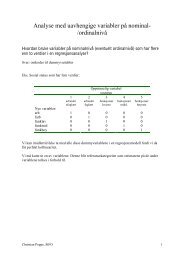an investigation of domestic laundry in europe - habits ... - SIFO
an investigation of domestic laundry in europe - habits ... - SIFO
an investigation of domestic laundry in europe - habits ... - SIFO
You also want an ePaper? Increase the reach of your titles
YUMPU automatically turns print PDFs into web optimized ePapers that Google loves.
3 Assessment <strong>of</strong> the functional perform<strong>an</strong>ce<strong>of</strong> Europe<strong>an</strong> <strong>laundry</strong> processes <strong>an</strong>d detergentsJ<strong>an</strong> Tore Halvorsen Gunnarsen3.1 IntroductionOne <strong>of</strong> the most import<strong>an</strong>t functions <strong>of</strong> a launder<strong>in</strong>g process is the wash perform<strong>an</strong>ce,def<strong>in</strong>ed by the elim<strong>in</strong>ation <strong>of</strong> visible soil <strong>an</strong>d sta<strong>in</strong>s from textiles.With the <strong>in</strong>troduction <strong>of</strong> Europe<strong>an</strong> ecolabell<strong>in</strong>g systems for both detergents<strong>an</strong>d wash<strong>in</strong>g mach<strong>in</strong>es, the focus on the ecological impact <strong>of</strong> do<strong>in</strong>g <strong>laundry</strong><strong>in</strong>creased, <strong>an</strong>d dur<strong>in</strong>g the past 20 years the Europe<strong>an</strong> countries have experienceda grow<strong>in</strong>g trend towards lower wash temperatures, as well as lower energy<strong>an</strong>d water consumption (Kemna)[18]. Unfortunately, these parametersare all related to wash perform<strong>an</strong>ce, <strong>an</strong>d by lower<strong>in</strong>g them we also reducewash perform<strong>an</strong>ce (Peel, Burnett, A<strong>in</strong>sworth)[19]. Consumers may or may notaccept a reduction <strong>in</strong> wash perform<strong>an</strong>ce, <strong>an</strong>d if the wash<strong>in</strong>g mach<strong>in</strong>es <strong>an</strong>d detergentsare not improved enough to equal this effect, we will sooner or laterf<strong>in</strong>d that common Europe<strong>an</strong> launder<strong>in</strong>g practices move towards higher washtemperatures aga<strong>in</strong>. We have already experienced that consumers wash theirclothes more <strong>of</strong>ten, which may be a way <strong>of</strong> solv<strong>in</strong>g the problem <strong>of</strong> a lowerwash perform<strong>an</strong>ce. Another way may be to use less environmental-friendlyremedies more frequently. Unfortunately these are not good alternatives forthe environment. Laundry <strong>habits</strong> are directly related to the satisfaction consumersf<strong>in</strong>d <strong>in</strong> hav<strong>in</strong>g fresh, cle<strong>an</strong> textiles; the prom<strong>in</strong>ence <strong>of</strong> these attitudeswill differ from region to region.Another import<strong>an</strong>t function <strong>in</strong> the <strong>laundry</strong> process is r<strong>in</strong>se perform<strong>an</strong>ce. Thelow water consumption <strong>in</strong> <strong>domestic</strong> wash<strong>in</strong>g mach<strong>in</strong>es has <strong>in</strong>creased the prob-


